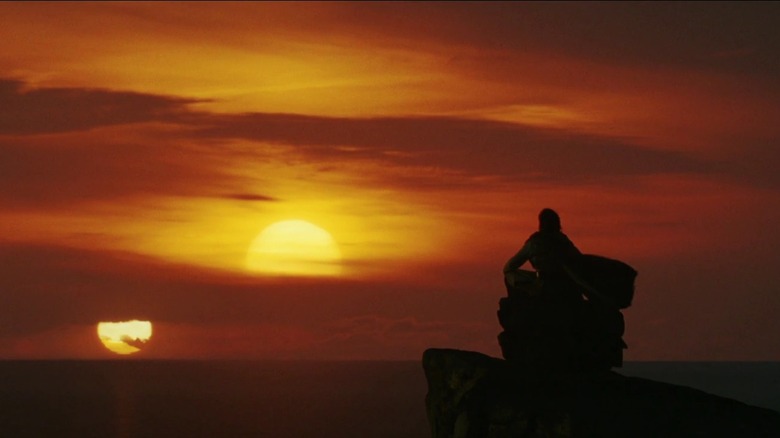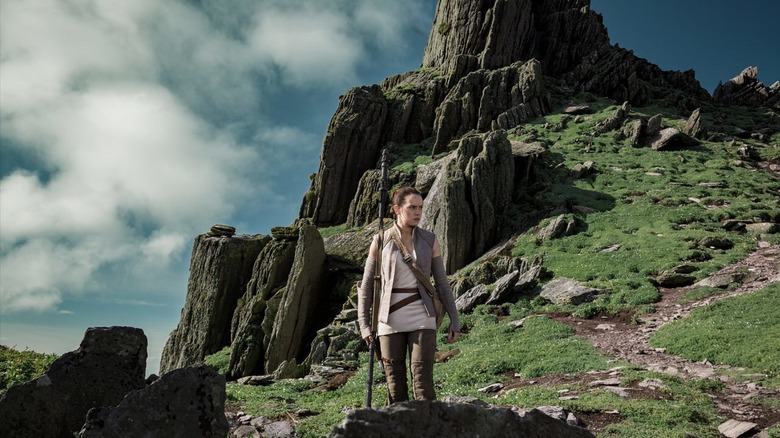Luke's Island In Star Wars: The Last Jedi Was A Logistical Nightmare To Film On
"Luke Skywalker has vanished," declared the opening text scroll of "Star Wars: The Force Awakens," and finding him became the movie's narrative thrust. The film ends with Rey (Daisy Ridley) finally finding Luke on a remote planet, Ahch-To, where he's living on a small rock island surrounded by a vast sea.
Director J.J. Abrams and his crew stressed "authenticity" with their location choices. "We wanted to make sure that wherever we went in this movie, you always felt you were really there," recounted Production Designer Rick Carter in an Ireland tourism video. For Luke's hiding place, they chose a truly remote site with history carved into its jagged exterior; Sceilg Mhichíl (Skellig Michael), a small island off the coast of County Kerry, Ireland, shaped like a mountain protruding out of the sea. Reportedly, Carter "stumbled across" a photo of the island and then Abrams fell in love at first sight.
Skellig is home to a preserved Christian monastery, built with stone in the 6th century; the island's name even comes from Saint Michael the Archangel. These small rock huts, and the 618 steps leading to them, blend into the natural landscape and sell the illusion of something once thriving but now faded into time. There was no more fitting site to portray the home of an ancient Jedi Temple.
The shoot drummed up a lot of publicity for Skellig and local news coverage, but "The Force Awakens" team only shot there for three days in July 2014. For the sequel, "The Last Jedi," writer/director Rian Johnson chose to keep Luke and Rey on the island for the movie's duration. That meant shooting there once more, and that brought plenty of logistical complications.
Shooting on Skellig Michael
In the making-of documentary "The Director and the Jedi," Johnson talks about the challenges of shooting on Skellig Michael during the initial "pre-shoot." This was where they shot the scene of Luke throwing away the Lightsaber that Rey hands to him (picking up where "The Force Awakens" left them), well before the rest of the movie. This took months of planning for only two days of photography. Why?
Skellig Michael is both a United Nations Educational, Scientific and Cultural Organization (UNESCO) historical site and a sanctuary site for birds (local species range from puffins to cormorants). That latter point is why the film has the Porgs – believe it or not, they aren't there just to sell toys, like most cute critters in "Star Wars" are meant to. No, it's because removing the traces of the birds from the island would've been impossible. So, Johnson and his crew leaned into it; if they caught bird noises in the background during recording, the diegetic source of those noises would be Porgs.
Then there's the remoteness of the island. While Skellig Michael is accessible to tourists, it's only under limited conditions. Landing tours only run from May to September year-round, and the steep and sharp cliffs of the island make it a dangerous trek (two separate tourist deaths only months apart in 2009 prompted a safety protocol re-evaluation). Thankfully, there was no reported harm to "The Last Jedi" crew, but one planned day of shooting was canceled due to high wind.
As "The Director and the Jedi" documents, the tree library on Ahch-To was not shot at Skellig. No, that was a set built at Pinewood Studios for when principal photography kicked off. Trying to build an elaborate set on Skellig would've been foolhardy at best. Often in filmmaking, practicality and safety have to come first.
The "Star Wars" movies and the documentary "The Director and the Jedi" are available on Disney+.

